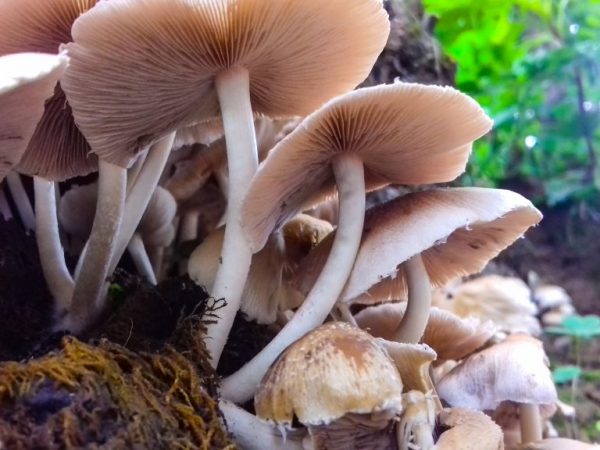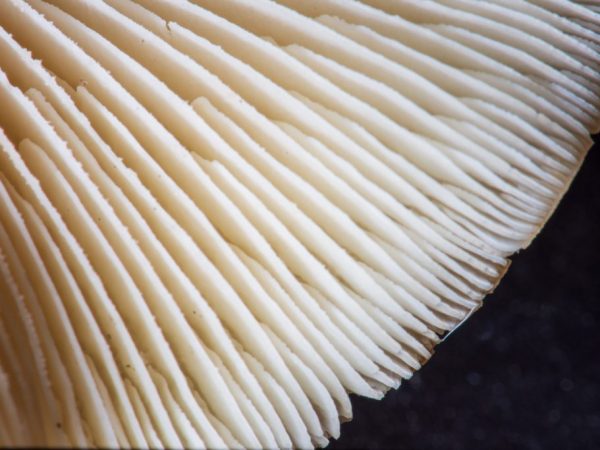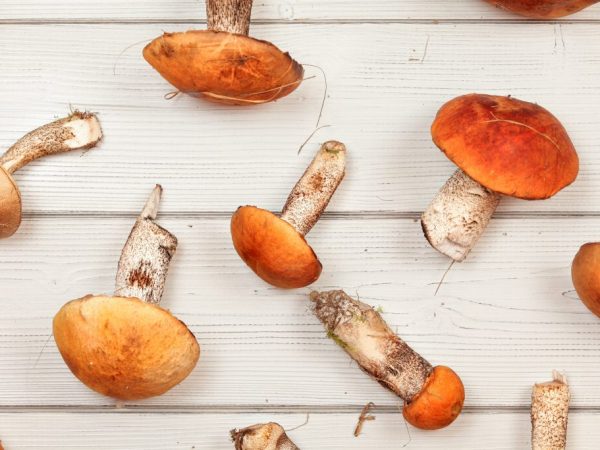The structure of the fungus
There is a huge variety of mushrooms in nature. To determine edibility, sometimes you need to know the structure of the fungus and other features.

The structure of the fungus
Features of the fungus organism
Mushrooms are united into a separate kingdom and occupy a special position in the system of the organic world, and their species number exceeds 100 thousand. Scientists estimate that in the near future at least 200,000 species will be described. The structure of fungi is such that these organisms have characteristics that make them similar to both the plant kingdom and the animal kingdom.
Similarities between mushrooms and plants
- unlimited growth;
- reproduction by spores;
- the presence of a cell wall;
- the presence of vacuoles in the cell;
- attached lifestyle;
- lack of a cell center;
- nutrition through the absorption process, etc.
Similarities between mushrooms and animals:
- heterotrophic nutrition;
- reserve nutrient - glycogen;
- the presence of chitin in the cell wall;
- the presence of urea as a metabolic product;
- lack of plastids;
- the presence of lysosomes containing digestive enzymes;
- the presence of small storage vacuoles.
The structure of mushrooms and their types is an important part of the science of mycology, which an ordinary mushroom picker needs to know about, so as not to confuse edible and inedible species.
The structure of mushrooms
In order to correctly understand the role of this kingdom, one should study the structure and vital activity of mushrooms, all the elements of the internal and external structure of their body, as well as how much they are interconnected.
Mycelium
The external structure of the fungus begins with its main component - the mycelium (mycelium), or the vegetative body. It is a system of long filaments in the substrate (soil). The thread is called hypha, it is impossible to see it with the naked eye. The clusters that these microscopic hyphae form become visible. We often see them as white (whitish) threads or strands.
The mycelium comes in different forms, each of which performs separate functions:
- rhizomorphs and sclerotia: ensuring a safe resting stage;
- cords and rhizoctonia: soil anchorage and spread;
- stroma: creating conditions for the persistence of disputes;
- films: destruction and absorption of cellulose.
The mycelium is capable of functioning for tens and hundreds of years, and the fruiting body (everything except the mycelium) rarely lives more than 5-10 days. In severe frosts and droughts, the mycelium stops working, goes into "mushroom hibernation", and then restores its vital activity. This is what ensures the long life of the mycelium.
Irina Selyutina (Biologist):
According to the structure of the body, real mushrooms are divided into lower (with non-cellular mycelium) and higher (with cellular mycelium), and in size - into macro- and. micromycetes.
Macromycetes are fungi in which the fruiting body is located above the soil surface. The fruiting body is the formation of the mycelium in which the formation and development of spores occurs. However, the bulk of fungi are micromycetes, or microscopically small fungal organisms.If the daughter cells, after their formation, do not separate from the mother, then a kind of chain of physiologically independent organisms is gradually formed. The so-called. pseudomycelium, such as yeast.
Fungi have no tissue. In highly organized forms, the hyphae are often intertwined very tightly and form a false tissue - plecthenchyma, from which fruiting bodies are formed.
Hat

The hat is the most important thing for the mushroom
The cap is considered the main part of the fruiting body. Its main function is to form spores with the help of organs located on the lower side of it, and in some, on the upper side. Spores are required for reproduction. Above is the peel, underneath is the pulp and hymenophore. Anyone who has ever picked mushrooms in the forest knows that there is a variety of cap shapes. Mushroom caps are divided into 9 types in shape:
- flat;
- concave;
- convex;
- conical;
- ovoid;
- with a central tubercle;
- bell-shaped;
- spherical;
- hemispherical.
The shape of the cap indicates age: young mushrooms usually have an ovoid or convex shape, while the cap of old ones is concave or flat.
The edges and center of the apex are most susceptible to change.
Skin
The structure of mushrooms is difficult to imagine without the skin and pulp. The skin, or cuticle, covers the top of the cap and acts as a shell, protecting the mushrooms from external influences. It can consist of one or several (usually 3) layers.
People who do not understand mushrooms and their structure say that they can always tell by color whether they are edible or inedible. This does not work in all cases. Factors that indicate the condition of the shell and the edibility of the fruit include the color and nature of the surface. Different species have different colors: red, gray, white, brown, yellow and even green. The color of the cuticle depends on the pigments present in its cells.
Color changes with age and environmental conditions.
The nature of the surface is able to tell in what climate the formation of the structure of the fungus takes place. There is a dry, slimy, scaly, fibrous surface, etc.
Pulp
The pulp (context) in the structure of mushrooms is the inner layer of the fruiting body. This is dead tissue, or trama, formed during the activity of sterile hyphae. The pulp is used to find out if mushrooms are poisonous or not.
Raw pulp is usually tasteless, but sometimes it is slightly bitter or sweet. The smell depends on the structural features of the mushrooms. It can be mushroom, ink or flour. The color of the flesh is whitish or gray. The context is thin and thick meaty. The pulp in a number of species is a receptacle for milky juice.
Consistency also provides information about the structure of the mushroom and is divided into woody, fleshy and cartilaginous. Mushrooms with a woody consistency have the strongest base.
Hymenophore

The structure of mushrooms is very complex.
The hymenophore is a part in the structure of the cap of an adult mushroom. It contains a spore-bearing layer, or hymenium, which allows more spores to be created for subsequent reproduction.
When studying the structure of fungi, it is taken into account that the hymenophore consists of various kinds of formations. There are such types of it: tubes, plates, thorns and needles. They are located vertically, the lower part is a group of holes, from which spores later pour out.
The types of hymenophores are determined by the general structure and activity of the fungi. The most common types are:
- smooth;
- lamellar;
- folded;
- tubular;
- prickly.
Differing in their structure, all types of hymenophores are intended for only one thing - the attachment of a spore-bearing layer (hymenium) to it.
Controversy
The peculiarities of the structure of the fungus include fungal spores that arise in special spore repositories. Tubular and lamellar species form spores on the walls of the formations themselves. Disputes are unicellular. They are often carried away by the wind over long distances.
In aquatic fungi, spores have adaptations for movement in a liquid medium - flagella. This allows them to move independently in the aquatic environment. Such spores are formed in zoosporangia and are characteristic of asexual reproduction of many lower fungi.
Their survivability and ability to adapt to the environment are noted. For example, in order to survive, late blight from a number of parasitic species overwinters on infected tubers. And pathogenic classes are resistant to physical and chemical disinfectants. By such processes, they ensure their existence for a long period. Therefore, it can be difficult to get rid of parasites.
Leg
The basis of cap mushrooms and their structure is the stem, because it performs a supporting function. In the substrate, it combines with the mycelium. There are cylindrical, fusiform and swollen forms (in different parts, but more often at the base) of the legs. By their consistency, they are dense, hollow and with a loose core. There are a variety of surface types: smooth, mesh, scaly and velvety.
Edible mushrooms
Information about the features of the structure and life of mushrooms will make it possible to understand whether they are edible or not. Taxonomists distinguish edible, conditionally edible, inedible and poisonous mushrooms. The latter are strictly prohibited, and the use of the second group triggers undesirable processes in the body.
It is difficult to understand whether the found mushrooms are poisonous. It is better to find illustrations of individual species before going into the forest. There are myths and misconceptions regarding the description of edible species:
- "During cooking, toxicity disappears, it is boiled down, evaporates if you add salt and vinegar to the water." The described method is used only when working with conditionally edible species, and not with poisonous ones.
- "If during cooking the abandoned onion turns blue, then there is a poisonous one among the mushrooms." Bulbs often turn blue for a number of other reasons related to their own characteristics. The same applies to the souring of milk, into which the "suspicious" mushroom is dipped.
- "Poisonous mushrooms don't taste or smell good." Some of the most dangerous mushrooms - white toadstool and panther fly agaric - have a good taste and smell, so in the mushroom business you should not trust the taste and aroma.
- "There are no parasites on inedible species." Poisonous species suffer from parasites much more often than edible ones.
Conclusion
People who understand the structure of mushrooms are more likely to confuse edible mushrooms with poisonous ones. Before going to the forest, you should familiarize yourself with the features of the mushroom kingdom and the structure of these organisms.


